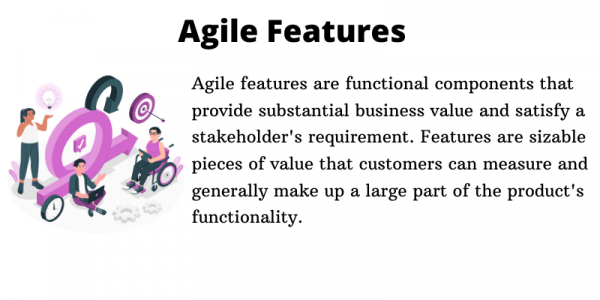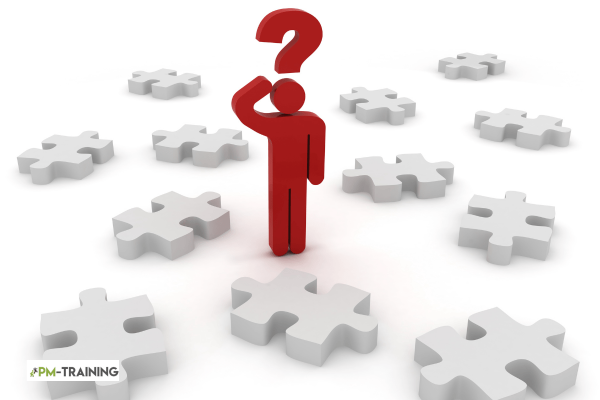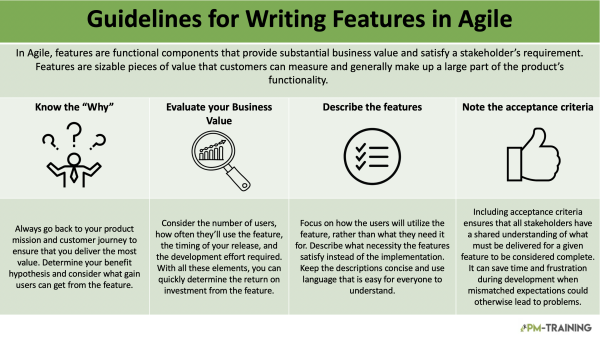An Agile Methodology is a popular approach that emphasizes collaboration, customer involvement, and fast delivery of a working product. One of the key concepts in Agile Methodology is the idea of features. In this blog post, we will discuss the features in Agile Methodology in greater detail.
We will cover what features are and why they are essential, what features are and how to write them, and the difference between features and epics in agile. By the end of this post, you should understand the features of Agile Methodology and how to use them effectively in your project management.
- What are the Features in Agile Methodology?
- What are Feature Points?
- User Stories and Features
- Why Should You Break Down Features into User Stories?
- Relationship Between Features and Epic in Agile
- Feature Breakdown Structure
- Guidelines for Writing Features in Agile
- Characteristics of Features in Agile
- Agile Feature Template
What are the Features in Agile Methodology?
In Agile, features are functional components that provide substantial business value and satisfy a stakeholder’s requirement. Features are sizable pieces of value that customers can measure and generally make up a large part of the product’s functionality.
They describe functionality at a macro level to create a better schedule and plan for the release of the finished product. Each feature is divided into several user stories as it is too hard to work on large chunks directly.
Features are integrated into the planning process at a high level and will need to be refined into specific tasks with time estimates. It is completed during sprint planning and releases planning.
Features could go by different names depending on which Agile Methodology you use.
- In Scrum, backlog items are often called features.
- In XP, features are called Stories.
- In DSDM are referred to as requirements
- In Agile UP, features are defined through requirements and use cases.

What are Feature Points?
In Agile Methodology, feature points encompass the work complexity, time investment, and know-how needed to finalize one feature. They are equivalent to story points but focused on a feature rather than a user story.
There are typically three different values that can be assigned to a feature point: small (S), medium (M), or large (L). The scale is relative and should be based on the team’s experience and understanding of the project.
Feature points are vital because they allow teams to quickly and easily estimate the size or complexity of a given feature without having to go into too much detail. It can be beneficial when many different features are vying for attention, and resources must be allocated accordingly.
When determining the feature points, you should consider the following factors:
- Number of users that will be using the feature
- The complexity of the feature
- The relative importance of the feature (e.g., must-have vs. nice-to-have)
- Availability of resources (e.g., developers, designers, etc.)
Once you have considered all these factors, you can assign a point value to each factor and then add up all the points to get an estimate of the total size of the feature.

User Stories and Features
Features are typically too large to work on directly, so they are broken down into smaller units called user stories.
The user story is the smallest unit of work and it’s an end goal expressed from the perspective of the software user rather than a feature. It should describe what a user needs to be able to do with a particular feature. User stories help to define the functionality of features.
A user story’s main objective is to express how a task will provide value for the customer. It’s essential to remember that “customers” can refer to internal customers or colleagues within your company who rely on your team, not just external end users.
To accommodate user stories that are small enough to fit into a sprint, the features must be big enough to deliver a considerable benefit upon rollout. You can utilize futures to manage large product functionalities.
Features play a role in managing product development from a macro level, which is being tackled at higher levels of management when discussing future endeavors. By writing out your user stories, you can ensure that your features meet your users’ needs.
Why Should You Break Down Features into User Stories?
Focusing on user stories helps to narrow down the overall focus.
In Scrum, a story is small and describes the work that needs to be done. A user story covers an entire functionality, regardless of its size. This way, progress can be measured incrementally. It’s also very doable so developers are able to handle it.
User stories fit into sprints
While stories can be completed within a sprint, features are too large to finish in this duration realistically. It makes task scheduling and planning simple.
User stories can capture the intent and desired outcome
A product manager can be more technically sound in describing a story’s outcome to a developer in terms they will understand.
User stories can lessen the risk
Because big stories are more complex, they also involve more risk. Breaking features into smaller stories helps mitigate risk. Any erroneous assumptions can be curtailed within a few days rather than several weeks into development.
Relationship Between Features and Epic in Agile
By definition, an agile epic is a large body of work that’s delivered through multiple sprints. Epics typically have a business case to support them and are significant enough to add value strategically. In other words, epics help organizations break their work into manageable chunks while staying focused on the bigger picture.
Epics can be separated into more concise chunks of work called Features. They derive from the needs and requests of customers or end users, and Agile teams size them or split them to best manage delivery. These epics have features with numerous releases and help deliver initiatives.
Meanwhile, features are small functionality that improves the experience for the user. End-users experience the benefits of features, which solve specific problems and add value to customers and businesses.
Feature Breakdown Structure
Agile development detailed planning uses the feature breakdown structure (FBS) approach, which more efficiently breaks down each feature into manageable units of work.
With better-written communication, the customer and development team can understand each other well to avoid ambiguity. It also helps in the progress tracking of work against value creation.
By breaking large features into smaller ones as the work progresses, you can avoid having to do a complete breakdown from the start. This way, details are fleshed out once they are needed for design and delivery.
Guidelines for Writing Features in Agile

The Product Managers are responsible for the features, meaning they decide what goes into each one and where it falls in priority on the backlog. However, aside from the Product Manager, other team members may be responsible for writing the features. There must be positive team culture and a psychologically safe agile environment
To write effective features, you can use the following guide:
Know “Why”
When writing your features, you should always go back to your product mission and customer journey to ensure that you deliver the most value. Determine your benefit hypothesis and consider what gain users can get from the feature.
Evaluate your business value
Consider the number of users, how often they’ll use the feature, the timing of your release, and the development effort required. With all these elements, you can quickly determine the return on investment from the feature.
If a feature provides great benefits for little cost, it is worth continuing and should be given priority status.
Describe the features
Focus on how the users will utilize the feature, rather than what they need it for. Describe what necessity the features satisfy instead of the implementation. Keep the descriptions concise and use language that is easy for everyone to understand.
Note the acceptance criteria
Knowing when a feature is considered “done” is critical. The conditions for this are similar to the acceptance criteria of user stories. Features provide a way to gauge the progress of product development. It will help to reduce ambiguity and keep track of work progress.
Including acceptance criteria ensures that all stakeholders have a shared understanding of what must be delivered for a given feature to be considered complete. It can save time and frustration during development when mismatched expectations could otherwise lead to problems.
Characteristics of Features in Agile
An effective feature should have the following characteristics:
- Gives measurable business value: The feature should be easily measurable and quantifiable in terms of financial returns or user satisfaction.
- Includes enough information to estimate the amount of work involved: The feature should contain enough information to enable the project team to evaluate the effort required and prioritize accordingly.
- It should be small enough that it’s possible to complete within three months (or a program increment)
- Testable: The feature should be able to be tested easily and give accurate results.

Agile Feature Template
When writing a feature, there is usually a template that you can use for guidance. Here is an example template:
- Feature Name: [insert name here]
- Description: [insert description here]
- Priority Level: [insert priority level here]
- Dependencies: [insert dependencies here]
- Story Points: [insert story points here]
- Acceptance Criteria: [insert acceptance criteria here]
Features provide a clear roadmap for developers when planning out product development. It plays an essential role in Agile Methodology by providing small increments of value which can be delivered quickly and easily understood by the users.
Writing the features is crucial to success in Agile development, so keep the features precise, measurable, and focused on providing maximum value for users. With a well-thought-out feature, you can be sure that your product will deliver maximum value to the users.
